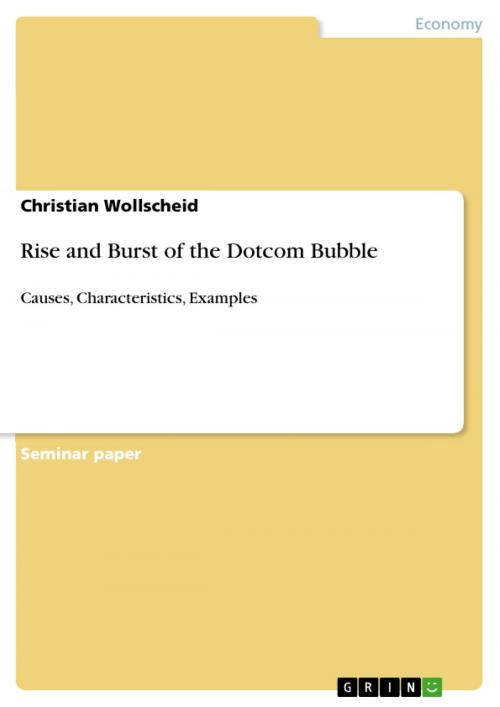Rise and Burst of the Dotcom Bubble
Causes, Characteristics, Examples
Business & Finance, Finance & Investing, Banks & Banking| Author: | Christian Wollscheid | ISBN: | 9783656232957 |
| Publisher: | GRIN Publishing | Publication: | July 11, 2012 |
| Imprint: | GRIN Publishing | Language: | English |
| Author: | Christian Wollscheid |
| ISBN: | 9783656232957 |
| Publisher: | GRIN Publishing |
| Publication: | July 11, 2012 |
| Imprint: | GRIN Publishing |
| Language: | English |
Seminar paper from the year 2012 in the subject Business economics - Banking, Stock Exchanges, Insurance, Accounting, grade: 1,3, Technical University of Applied Sciences Mittelhessen, language: English, abstract: The Dotcom bubble, also known as the 'Internet bubble' or the 'Information technology bubble' was a speculative bubble of stock prices of mainly American Internet companies during the time from 1995 until 2000 when many investors believed that a 'new era' was upon them. In only two years, the Internet sector grew over 1000% of its public equity and equalled nearly 6% of the market capitalization of the United States and over 20% of all public traded equity volume in the US. It had its peak on March 10, 2000 with a NASDAQ score of 5,048.62. This period was characterized by lots of establishments of companies in the Internet sector. They were called 'Dotcom Companies' because of the '.com' in the end of an URL that comes from the word 'commercial'. The bubble burst during the years 2000 until 2002 when the NASDAQ lost nearly 80% of its value, many companies like Pets.com failed completely and over $7 trillion in market value were destroyed. With this paper, the author tries to explain the rise and fall of Internet stock prices during that period. For this purpose, the general causes and characteristics of financial bubbles get described before the application to the Dotcom bubble follows. Additionally, some company examples and survivors and losers of the bubble like pets.com, Webvan or Ebay get introduced. Because the bubble mainly took place in the United States, the author will focus on American company examples and the American stock exchange.
Seminar paper from the year 2012 in the subject Business economics - Banking, Stock Exchanges, Insurance, Accounting, grade: 1,3, Technical University of Applied Sciences Mittelhessen, language: English, abstract: The Dotcom bubble, also known as the 'Internet bubble' or the 'Information technology bubble' was a speculative bubble of stock prices of mainly American Internet companies during the time from 1995 until 2000 when many investors believed that a 'new era' was upon them. In only two years, the Internet sector grew over 1000% of its public equity and equalled nearly 6% of the market capitalization of the United States and over 20% of all public traded equity volume in the US. It had its peak on March 10, 2000 with a NASDAQ score of 5,048.62. This period was characterized by lots of establishments of companies in the Internet sector. They were called 'Dotcom Companies' because of the '.com' in the end of an URL that comes from the word 'commercial'. The bubble burst during the years 2000 until 2002 when the NASDAQ lost nearly 80% of its value, many companies like Pets.com failed completely and over $7 trillion in market value were destroyed. With this paper, the author tries to explain the rise and fall of Internet stock prices during that period. For this purpose, the general causes and characteristics of financial bubbles get described before the application to the Dotcom bubble follows. Additionally, some company examples and survivors and losers of the bubble like pets.com, Webvan or Ebay get introduced. Because the bubble mainly took place in the United States, the author will focus on American company examples and the American stock exchange.















